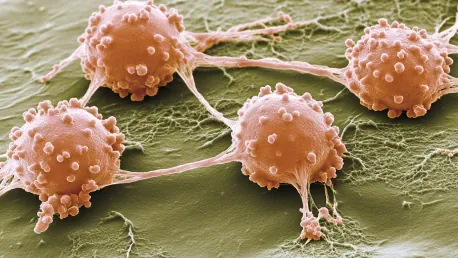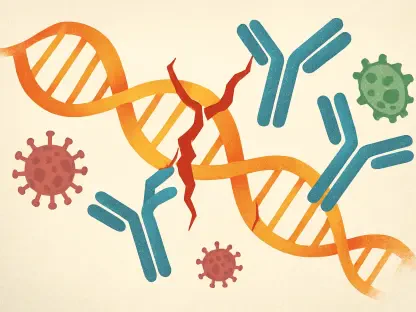Cancer biology has traditionally emphasized the competitive nature of tumor cells as they compete fiercely for limited resources. However, recent research led by Carlos Carmona-Fontaine at New York University has unveiled a groundbreaking and surprising discovery that cancer cells also exhibit cooperative behavior to source nutrients, which significantly supports tumor growth. This paradigm shift in our understanding of tumor cell interactions provides exciting new avenues for therapeutic interventions, as detailed in the study published in the prestigious journal Nature.
Cooperative Behavior in Tumor Cells
Traditionally, scientists have believed that cancer cells primarily compete for nutrients, with the most aggressive cells eventually dominating tumor growth over time. However, this new research challenges that long-standing view by demonstrating that cancer cells are capable of collaborating, particularly in environments where nutrients are scarce. This cooperation among cancer cells allows them to enhance their survival rates as well as their proliferation, particularly in hostile conditions where resources are limited.
Drawing on ecological parallels, the study likens cancer cell cooperation to behaviors observed in nature, such as how penguins huddle together for warmth during winter or how yeast cells work together to find nutrients during starvation. Similarly, in nutrient-scarce environments, cancer cells might collaborate to optimize their chances of survival and proliferation. This dual role of both competition and cooperation in tumor evolution presents a nuanced understanding of how tumors develop and thrive.
Innovative Research Methodologies
In order to investigate this cooperative behavior, researchers employed sophisticated and innovative technologies, including a robotic microscope and specialized image analysis software. These advanced tools enabled the rapid counting and detailed observation of millions of cells under various conditions. By examining tumor cell cultures at varying densities and nutrient levels, the study provided significant insights into the behavior and interactions of tumor cells.
The data revealed that cancer cells show a strong propensity to cooperate when deprived of amino acids, a key nutrient necessary for their growth and survival. Furthermore, the benefits of this cooperative behavior were more pronounced in higher-density cell populations, clearly indicating that the cooperation among tumor cells is indeed density-dependent. This finding underscores the complex interactions and adaptations that cancer cells can employ to thrive in challenging environments.
Role of Oligopeptides and Enzyme CNDP2
Further investigation into the cooperative behavior of cancer cells identified oligopeptides—protein fragments composed of amino acid chains—as a crucial nutrient source. Rather than internalizing these peptides directly, cancer cells secrete an enzyme that breaks them down into free amino acids, creating a shared nutrient pool that benefits the entire cell population. This extracellular process allows the cells to efficiently utilize the available nutrients in their environment.
The enzyme responsible for this critical feeding mechanism, CNDP2, emerged as a pivotal factor in the cooperative nutrient-acquisition process. Researchers tested various drugs to inhibit the function of CNDP2 and found that bestatin, an existing drug, effectively hindered the cancer cells’ ability to digest oligopeptides into free amino acids. The inhibition of this enzyme deprived cancer cells of essential nutrients, ultimately leading to their extinction. This finding highlights a potential therapeutic target in disrupting the cooperative behaviors that support tumor growth.
Genetic Validation and Therapeutic Potential
To further validate these findings, researchers employed the genetic editing tool CRISPR to knock out the Cndp2 gene in tumor cells. This genetic modification significantly reduced tumor growth in laboratory mice, an effect that was further intensified by limiting the dietary amino acids available to the tumors. The combination of genetic modification and dietary restriction presents a promising avenue for reducing tumor growth and enhancing the effectiveness of cancer treatments.
Moreover, combining bestatin treatment with a low-amino-acid diet proved even more effective in curtailing tumor growth. This approach highlights a potential therapeutic strategy that targets the cooperative mechanisms underpinning cancer cell survival. By disrupting the collective nutrient acquisition process, cancer therapies may become more effective in combating the disease and preventing tumor proliferation.
Broader Implications and Collaborative Efforts
The recent revolutionary discovery by Carlos Carmona-Fontaine and his team at New York University has revealed a surprising new aspect of cancer cell behavior: cooperation. Their research uncovers that cancer cells don’t just compete; they also work together to source nutrients, which greatly enhances tumor growth. This discovery represents a significant shift in how we understand tumor cell interactions and opens up novel avenues for therapeutic intervention. The findings, published in the renowned journal Nature, provide new insights that could transform cancer treatment strategies. By exploring how cancer cells coordinate to access essential resources, scientists can now devise innovative approaches to disrupt these cooperative interactions, potentially leading to more effective treatments. This breakthrough highlights the importance of re-evaluating traditional views on cancer cell behavior and offers hope for future advancements in cancer therapy.









